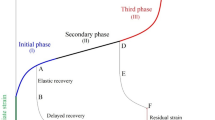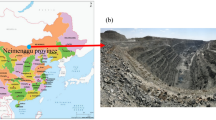Abstract
In this work, the massive landslide of Daguangbao was modeled in 3D using the material point method (MPM). The paper focuses on modeling the failure, the run-out, and the final deposition of the failed mass in 3D. The numerical model considers in detail the distribution of materials within the domain. The materials were modeled as elastoplastic with an exponential strain-softening law. In addition, a frictional law was considered for the mass and topography interaction. The results obtained in this work show a good coincidence with the reported data in terms of kinetic energy released, failure mechanism, the final configuration of topography on the characteristic section, affected area by the event, and the formation of a nearly vertical wall in the region of the Daguangbao mountain area. Additionally, the 3D model allowed us to estimate the region affected by the event and understand the possible movement of the mass during the filling process of the Huangdongzi Valley. The analysis of the material deposited along the valley allowed the establishment of zones of potential variation of porosities, an essential characteristic given the formation of the natural dam over the Huangdongzi Valley.



















Similar content being viewed by others
References
Abe K, Nakamura S, Nakamura H, Shiomi K (2017) Numerical study on dynamic behavior of slope models including weak layers from deformation to failure using material point method. Soils Found 57:155–175
Bardenhagen SG, Brackbill JU, Sulsky D (2000) The material-point method for granular materials. Comput Methods Appl Mech Eng 187:529–541
Bardenhagen SG, Guilkey JE, Roessig KM, Brackbill JU, Witzel WM, Foster JC (2001) An improved contact algorithm for the material point method and application to stress propagation in granular material. CMES Comput Model Eng Sci 2:509–522
Bardenhagen SG, Kober EM (2004) The generalized interpolation material point method. Comput Model Eng Sci 5:477–496
Belytschko T, Liu WK, Moran B, Elkhodary K (2013) Nonlinear finite elements for continua and structures. John wiley & sons, London
Bhandari T, Hamad F, Moormann C, Sharma KG, Westrich B (2016) Numerical modelling of seismic slope failure using MPM. Comput Geotech 75:126–134
Brackbill JU, Ruppel HM (1986) FLIP: a method for adaptively zoned, particle-in-cell calculations of fluid flows in two dimensions. J Comput Phys 65:314–343
Cui F, Xiong C, Wu Q, Xu C, Li N, Wu N, Cui L (2021) Dynamic response of the Daguangbao landslide triggered by the Wenchuan earthquake with a composite hypocenter. Geomat Nat Haz Risk 12:2170–2193
Cui S, Yang Q, Pei X, Huang R, Guo B, Zhang W (2020) Geological and morphological study of the Daguangbao landslide triggered by the Ms. 8.0 Wenchuan earthquake, China. Geomorphology 370:107394
D. M. Cruden and D. J. Varnes, "Landslides: investigation and mitigation. Chapter 3-Landslide types and processes," Transportation research board special report, 1996.
Fern EJ (2019) Modelling tunnel-induced deformations with the material point method. Comput Geotech 111:202–208
Fern J, Rohe A, Soga K, Alonso E, Rohe A, Soga K, Alonso E (2019) The Material Point Method for Geotechnical Engineering. CRC Press, Boca Raton
Fernández F (2020) Numerical Modeling of Geotechnical Problems of Large Deformations Using the Material Point Method (in Portuguese). Pontifical Catholic University of Rio de Janeiro, Rio de Janeiro, Brazil.
Fernández F, AmaralVargas Do, Velloso RQ (2019) A 3D discretization procedure for the material point method (MPM). Comput Particle Mech 7:725–733
Fernández F, Rojas J, Vargas E, Velloso Q, Dias D (2021) Three-dimensional face stability analysis of shallow tunnels using numerical limit analysis and material point method. Tunnelling and Underground Sp Technol 112:103904
Fernández F, Vargas J (2018) “Considerations on the use of MPM (Material Point Method) in numerical simulation of deformation processes in structural geology (in Portuguese),” in 49º Brazilian Geology Congress / 9º Symposium of the Cretaceous of Brazil / VIIAt: Rio de Janeiro, Brasil. Brasil, Rio de Janeiro
Fávero Neto AH, Askarinejad A, Springman SM, Borja RI (2020) Simulation of debris flow on an instrumented test slope using an updated Lagrangian continuum particle method. Acta Geotech 15:2757–2777
GSISP, Geological Survey Institute of Sichuan. Daguangbao landslide survey (in Chinese), Chengdu, China, 2010.
Harlow F (1964) The particle-in-cell computing method for fluid dynamics. Methods Comput Phys 3:319–343
He M, Sousa LRe, Müller A, Vargas E Jr, Sousa RL, Oliveira CS, Gong W (2019) Numerical and safety considerations about the Daguangbao landslide induced by the 2008 Wenchuan earthquake. J Rock Mech Geotech Eng 11:1019–1035
Huang R, Pei X, Fan X, Zhang W, Li S, Li B (2012) The characteristics and failure mechanism of the largest landslide triggered by the Wenchuan earthquake, May 12, 2008, China. Landslides 9:131–142
I. K. J. Al-Kafaji, "Formulation of a Dynamic Material Point Method ( MPM ) for Geomechanical Problems," University of Stuttgart, 2013.
Li X, Tang X, Zhao S, Yan Q, Wu Y (2020) MPM evaluation of the dynamic runout process of the giant Daguangbao landslide. Landslides 18:1509–1518
Liu C, Sun Q, Jin F, Zhou GGD (2017) A fully coupled hydro-mechanical material point method for saturated dense granular materials. Powder Technol 314:110–120
Liu X, Wang Y, Li D-Q (2020) Numerical simulation of the 1995 rainfall-induced Fei Tsui Road landslide in Hong Kong: new insights from hydro-mechanically coupled material point method. Landslides 17:2755–2775
Lysmer J, Kuhlemeyer RL (1969) Finite dynamic model for infinite media. J Eng Mech Div 95:859–878
Müller A, Vargas EA (2019) Stability analysis of a slope under impact of a rock block using the generalized interpolation material point method (GIMP). Landslides 16:751–764
Nian T-K, Zhang Y-J, Wu H, Chen G-Q, Zheng L (2020) Runout simulation of seismic landslides using discontinuous deformation analysis (DDA) with state-dependent shear strength model. Can Geotech J 57:1183–1196
Qiu G, Henke S, Grabe J (2011) Application of a coupled Eulerian-Lagrangian approach on geomechanical problems involving large deformations. Comput Geotech 38:30–39
S. Gowda, C. Moormann, D. Franz and E. Stolle, "Application of Geo-contact to pile installation using the CPDI variant of Material Point Method (MPM)," 2019.
Song Y, Huang D, Cen D (2016) Numerical modelling of the 2008 Wenchuan earthquake-triggered Daguangbao landslide using a velocity and displacement dependent friction law. Eng Geol 215:50–68
Sulsky D, Chen Z, Schreyer HL (1994) A particle method for history-dependent materials. Comput Methods Appl Mech Eng 118:179–196
Sulsky D, Schreyer HL (1996) Axisymmetric form of the material point method with applications to upsetting and Taylor impact problems. Comput Methods Appl Mech Eng 139:409–429
Sulsky D, Zhou SJ, Schreyer HL (1994) Application of a praticle-in-cell method to solid mechanics. Comp Phys Commun 87:179–196
Tang C, Van Westen CJ (2018) Atlas of Wenchuan-Earthquake Geohazards: Analysis of co-seismic and post-seismic Geohazards in the area affected by the 2008 Wenchuan Earthquake. Science Press, Jerusalem
USGS, Magnitude 7.9—Eastern Sichuan, China, 2008 May 12 06:28:01UTC, 2008.
Vaucorbeil AD, Nguyen VP, Sinaie S, Wu JY (2019) Material point method after 25 years: theory, implementation, applications. Adv Appl Mech 53:185–398
Wu J-H, Do TN, Chen C-H, Wang G (2017) New geometric restriction for the displacement–constraint points in discontinuous deformation analysis. Int J Geomech 17:E4016002
Xu X, Jin F, Sun Q, Soga K, Zhou GGD (2018) Three-dimensional material point method modeling of the runout behavior of the Hongshiyan landslide. Canadian Geotech J 56(9):1318–1337
Yerro A, Alonso EE, Pinyol NM (2015) The material point method for unsaturated soils. Géotechnique 65:201–217
Yuan WH, Wang HC, Zhang W, Dai BB, Liu K, Wang Y (2021) Particle finite element method implementation for large deformation analysis using Abaqus. Acta Geotech 2:2449–2462
Zhang X, Chen Z, Liu Y (2016) The material point method: a continuum-based particle method for extreme loading cases. Academic Press, New York
Zhang Y, Chen G, Zheng L, Li Y, Wu J (2013) Effects of near-fault seismic loadings on run-out of large-scale landslide: a case study. Eng Geol 166:216–236
Zhang Y, Zhang J, Chen G, Zheng L, Li Y (2015) Effects of vertical seismic force on initiation of the Daguangbao landslide induced by the 2008 Wenchuan earthquake. Soil Dyn Earthq Eng 73:91–102
Zienkiewicz OC, Taylor RL, Zhu JZ (2005) The finite element method: its basis and fundamentals. Elsevier, Amsterdam
Acknowledgements
This study was financed in part by the Coordenação de Aperfeiçoamento de Pessoal de Nível Superior—Brasil (CAPES)—Finance Code 001.
Author information
Authors and Affiliations
Corresponding author
Ethics declarations
Conflict of interest
There are no known conflicts of interest associated with this publication.
Additional information
Publisher's Note
Springer Nature remains neutral with regard to jurisdictional claims in published maps and institutional affiliations.
Supplementary Information
Below is the link to the electronic supplementary material.
Supplementary file1 (MP4 25775 kb)
Rights and permissions
Springer Nature or its licensor (e.g. a society or other partner) holds exclusive rights to this article under a publishing agreement with the author(s) or other rightsholder(s); author self-archiving of the accepted manuscript version of this article is solely governed by the terms of such publishing agreement and applicable law.
About this article
Cite this article
Fernández, F., Vargas, E., Muller, A.L. et al. Material point method modeling in 3D of the failure and run-out processes of the Daguangbao landslide. Acta Geotech. (2023). https://doi.org/10.1007/s11440-023-02152-4
Received:
Accepted:
Published:
DOI: https://doi.org/10.1007/s11440-023-02152-4




